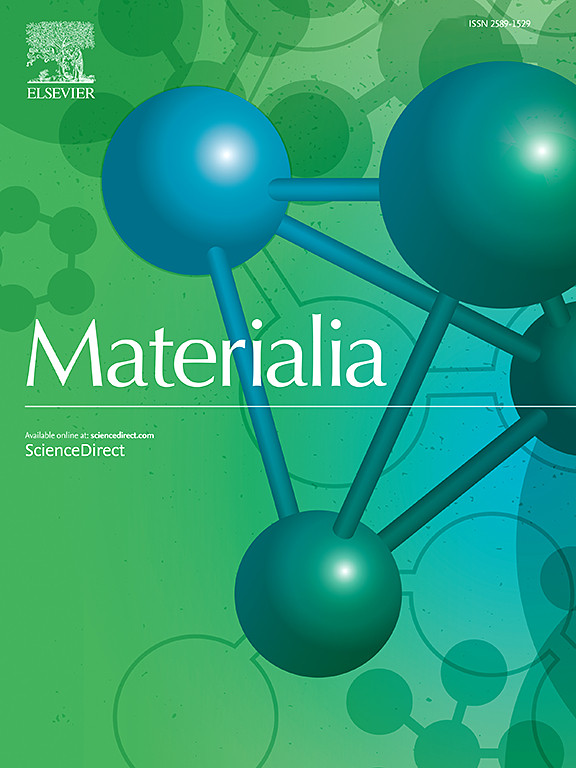Uncovering the mechanism behind a two-step infiltration during layered wide-gap brazing of a Ni-base superalloy using a B-Containing filler metal
IF 3
Q2 MATERIALS SCIENCE, MULTIDISCIPLINARY
引用次数: 0
Abstract
This study investigates the mechanisms resulting in a two-step infiltration process during layered wide-gap brazing of the MAR-M247/BNi-9 system for repair of high-temperature Ni superalloy components. Differential scanning calorimetry was coupled with electron microscopy and 3D X-ray microscopy to better quantify the two-step infiltration process. It was found that significant diffusional homogenization between braze alloy and MAR-M247 particles, occurred prior to liquation. As a result, only about 15% of the braze melted during Stage 1 of layered wide-gap brazing as compared to approximately 49% when only the melting of pure BNi-9 was considered for the same temperature interval. Stage 1 melting began at the ternary eutectic transformation temperature, 1053 °C, with the complete melting of Ni3B and partial melting of -Ni. Upon liquation, the braze liquid readily infiltrated the MAR-M247 skeleton via capillary action. As a result of rapid boron diffusion into the MAR-M247 skeleton from the infiltrating braze, extensive base metal dissolution and eventual diffusional solidification occurred, with Stage 1 infiltration terminating at 1073 °C. Stage 2 melting and infiltration began at 1102 °C with the re-melting of the partially infiltrated braze as well as melting of remaining un-infiltrated braze atop the layered brazement, with near complete infiltration attained by 1150 °C. Further, it was found that infiltration behavior varied between Stages 1 and 2, with 58% and 40% of the MAR-M247 skeleton infiltrated after 120 s and 228 s, respectively. Kinetic differences were likely influenced by: (i) transition from rapid to sluggish skeletal dissolution regimes, and an (ii) alteration of the MAR-M247 pore network structure

揭示了含b钎料层状宽间隙钎焊镍基高温合金时两步渗透的机理
本研究探讨了在用于修复高温镍超合金部件的 MAR-M247/BNi-9 系统的分层宽间隙钎焊过程中产生两步渗透过程的机理。差示扫描量热法与电子显微镜和三维 X 射线显微镜相结合,更好地量化了两步渗透过程。研究发现,在液化之前,钎焊合金和 MAR-M247 颗粒之间发生了明显的扩散均匀化。因此,在分层宽间隙钎焊的第一阶段,只有约 15%的钎料熔化,而在相同温度区间,仅考虑纯 BNi-9 的熔化时,熔化率约为 49%。第一阶段熔化始于三元共晶转变温度 1053 °C,Ni3B 完全熔化,γ-Ni 部分熔化。液化时,钎焊液很容易通过毛细作用渗入 MAR-M247 骨架。由于硼从渗入的钎焊液中迅速扩散到 MAR-M247 骨架中,发生了广泛的贱金属溶解和最终的扩散凝固,第一阶段的渗入在 1073 °C 时终止。第二阶段的熔化和渗入始于 1102 ℃,部分渗入的钎料重新熔化,分层钎料顶部剩余的未渗入钎料也开始熔化,到 1150 ℃ 几乎完全渗入。此外,研究还发现,第 1 和第 2 阶段的浸润行为各不相同,在 120 秒和 228 秒后,分别有 58% 和 40% 的 MAR-M247 骨架被浸润。动力学差异可能受到以下因素的影响(i) 从骨架快速溶解到缓慢溶解的转变,以及 (ii) MAR-M247 孔隙网络结构的改变
本文章由计算机程序翻译,如有差异,请以英文原文为准。
求助全文
约1分钟内获得全文
求助全文
来源期刊

Materialia
MATERIALS SCIENCE, MULTIDISCIPLINARY-
CiteScore
6.40
自引率
2.90%
发文量
345
审稿时长
36 days
期刊介绍:
Materialia is a multidisciplinary journal of materials science and engineering that publishes original peer-reviewed research articles. Articles in Materialia advance the understanding of the relationship between processing, structure, property, and function of materials.
Materialia publishes full-length research articles, review articles, and letters (short communications). In addition to receiving direct submissions, Materialia also accepts transfers from Acta Materialia, Inc. partner journals. Materialia offers authors the choice to publish on an open access model (with author fee), or on a subscription model (with no author fee).
 求助内容:
求助内容: 应助结果提醒方式:
应助结果提醒方式:


